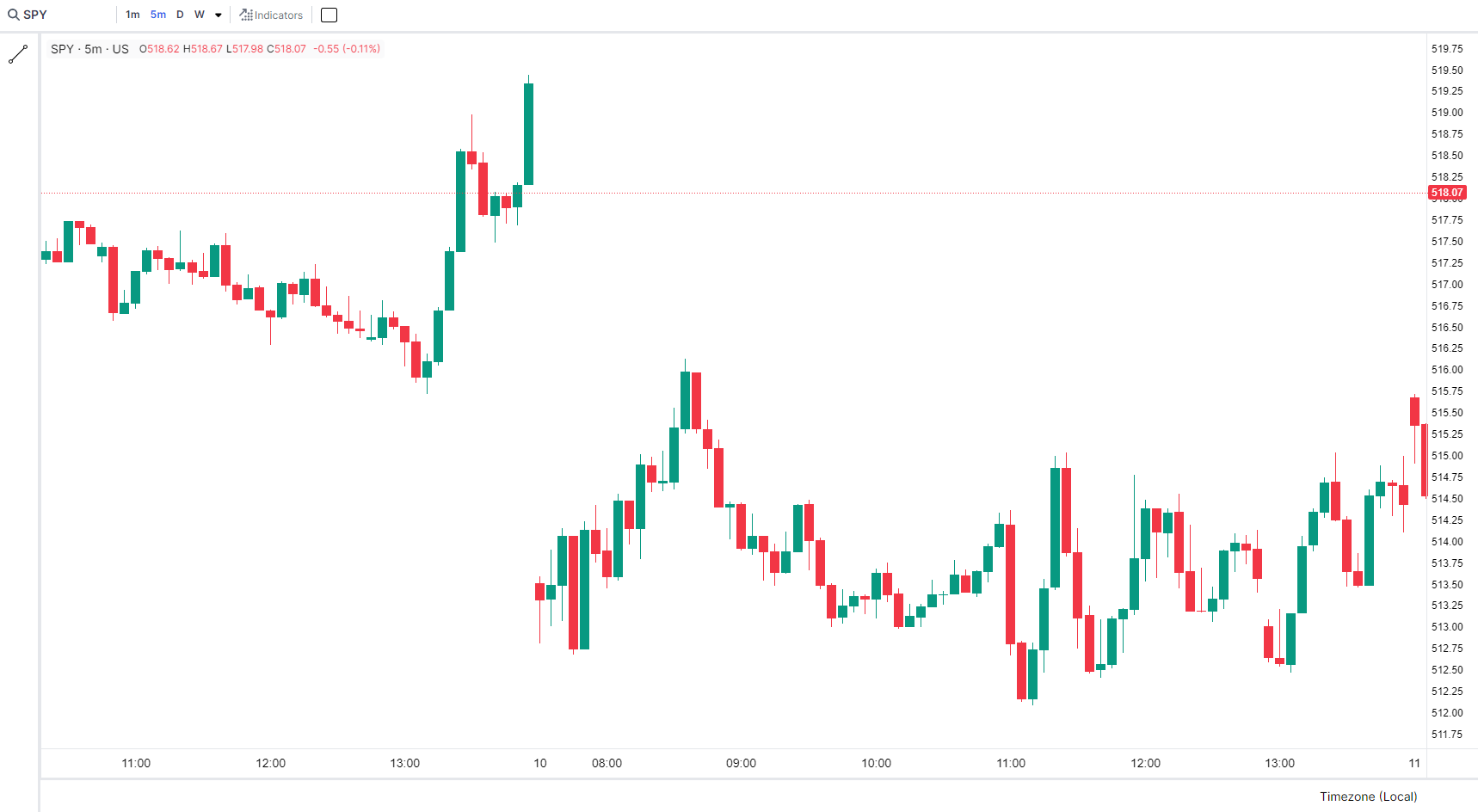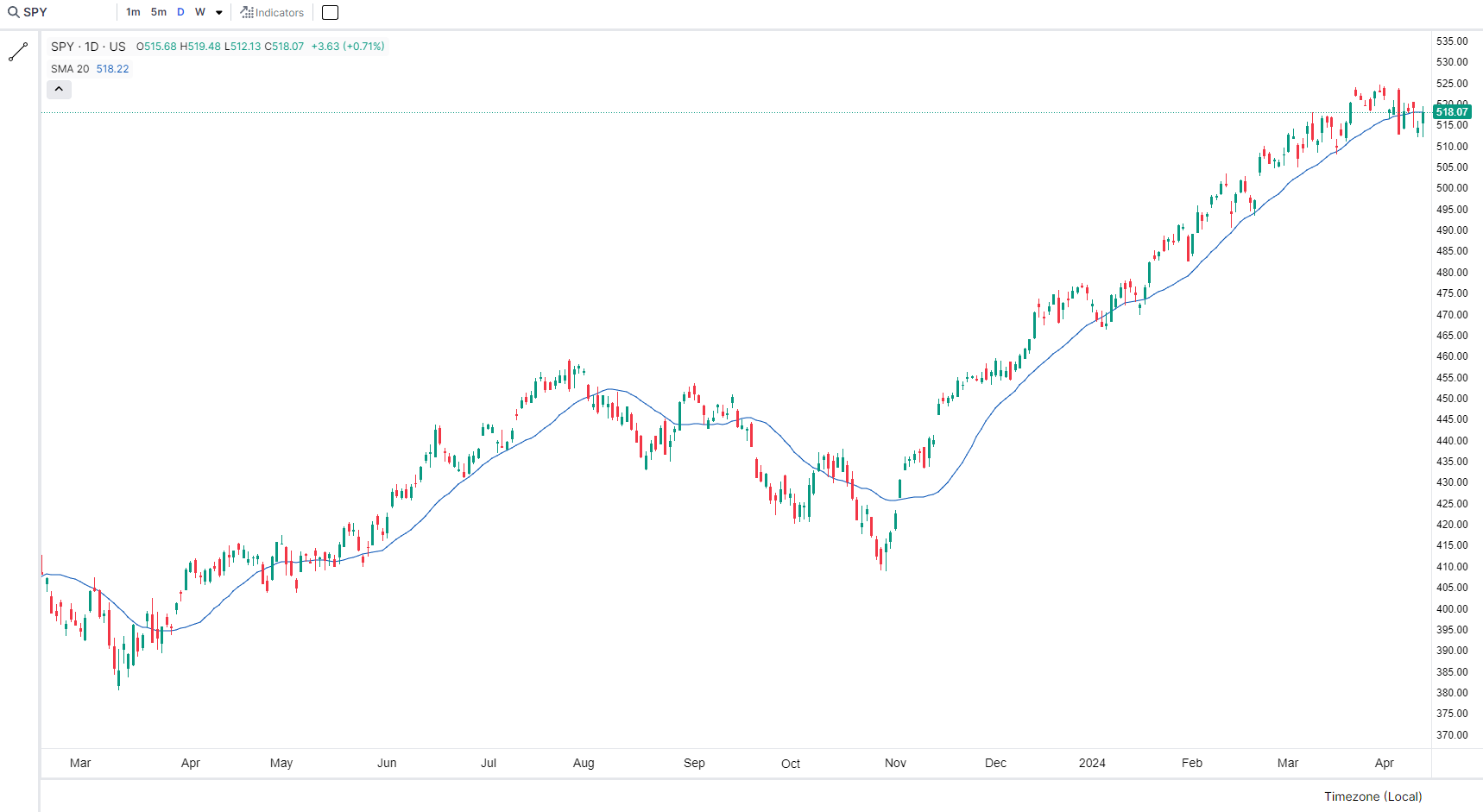CPI Report Spurs Market Tremors: March 2024 Analysis
Analyzing the inflationary trends following the March 2024 Consumer Price Index (CPI) report.
Last updated: April 11, 2024
Author: Nathan Nobert
The unveiling of the March 2024 Consumer Price Index (CPI) report has sent ripples through the financial markets, drawing attention to the nuanced interplay between inflationary trends and market dynamics. As the CPI surged by 0.4% month-over-month, matching its March pace, and ascended to a 3.5% increase year-over-year, the statistics have both analysts and investors recalibrating their expectations and strategies.
Top Index Performers Current Prices
- VTI:290.39 (-3.09%)
- VOO:539.14 (-2.94%)
Click tickers to view advanced details
Key Takeaways
- - CPI is up slightly from what was expected, 3.5% YoY actual vs 3.4% YoY expected.
- - Understanding why CPI matters for investors.
- - Implications for investors, and future outlook based on the CPI report.
A Glimpse into March 2024 CPI & Insights
The CPI report, a barometer for inflation that gauges the average change over time in the prices paid by urban consumers for a market basket of consumer goods and services, indicates a sustained inflationary pressure within key sectors of the economy. Notably, the indices for shelter and gasoline have contributed significantly to the month's inflation, signalling heightened costs in housing and energy that could influence broader market sentiment and consumer spending patterns.

As seen in the above image, the market reacted to the CPI report with a sharp drop in the opening price. Throughout the day, the market bounced around and maintained a neutral stance. Many could see this as a positive sign, as the market did not continue to drop after the initial shock.
Why The CPI Report Matters
The CPI is more than just a number; it's a critical economic indicator that affects monetary policy, investment strategies, and the overall health of the financial markets. March's report, showing a steady climb in inflation, underscores ongoing challenges in managing cost pressures amid fluctuating market conditions. Here's why this matters:
- Inflationary Trends: A 3.5% year-over-year increase paints a picture of enduring inflation, necessitating careful monitoring and strategic adjustments by policymakers and investors alike.
- Sector-Specific Impacts: The rise in indices for shelter and gasoline highlights sector-specific volatility, offering investment insights and cautionary tales for market participants.
- Monetary Policy Implications: Sustained inflation may influence the Federal Reserve's decisions on interest rates, which in turn affect market liquidity and investment returns.
Additionally, the CPI report serves as a forward-looking indicator, offering clues about future economic conditions and potential shifts in consumer behavior. As businesses and consumers adjust to the reality of higher prices, their spending habits may change, affecting everything from stock market trends to real estate values.
This makes the CPI report an invaluable tool for forecasting economic shifts, allowing investors to anticipate market movements and adjust their strategies accordingly. Understanding these implications can empower stakeholders to make informed decisions, balancing risk and opportunity in an ever-evolving economic landscape. Recent reports of the
Decoding the Market Response
The March CPI report has provided fodder for a range of market responses, from cautious optimism in certain sectors to reevaluations of risk and strategy among investors. The nuanced data, reflecting variances in food, energy, and core inflation, offers a lens through which to anticipate potential shifts in market dynamics and consumer behavior.
The reaction to the March CPI report underscores the complex relationship between inflation data and market sentiment. Investors and analysts pore over these figures, seeking to decode underlying trends that could signal either opportunities or red flags within various sectors
For instance, while some may view an uptick in energy prices as a sign of growing demand and economic recovery, others might see it as a precursor to higher costs and reduced consumer spending power.
Similarly, changes in food inflation can impact sectors far beyond just agriculture and retail, affecting disposable income and, by extension, the broader economy. This multifaceted interpretation of CPI data highlights the critical role of detailed analysis in shaping investment strategies and economic outlooks.
Forward-Looking Market Projections
Looking ahead, the financial markets are poised on the cusp of potential volatility, driven by inflationary pressures and economic indicators like the CPI. Investors and analysts alike will be watching closely for signs of how these trends might influence market directions, interest rates, and investment opportunities.
In this environment of uncertainty, the strategic importance of diversification and hedging against inflation becomes increasingly apparent. Investors may start to gravitate towards assets traditionally seen as safer during volatile periods, such as precious metals, real estate, or even certain cryptocurrencies, viewed by some as digital gold.
Moreover, sectors that have historically demonstrated resilience in the face of inflationary pressures, such as utilities and consumer staples, might see renewed interest. As market participants navigate this landscape, the ability to quickly adapt investment portfolios in response to evolving CPI data and economic indicators will be key to capitalizing on emerging opportunities and mitigating risks.
Key Takeaways for Investors
- - The CPI's indication of sustained inflationary pressure necessitates a vigilant approach to investment and financial planning.
- - Sector specific data, particularly concerning shelter and gasoline, provide critical insights for targeted investment strategies.
- - The broader market impact of inflation trends underscores the importance of staying informed and adaptable in an ever changing economic landscape.
Analyzing the S&P's performance over the last year, we can see a steady increase in value. This is a good sign for investors, as the market has been able to maintain a positive trajectory despite the recent CPI report. At the time of writing, the 52 week low was $404.36 and the market is currently breaking new all-time highs. You can read our analysis on the

Understanding the CPI Dynamics
March's CPI report, reflecting a 0.4% increase on a month-over-month basis and a 3.5% surge year-over-year, presents a complex landscape of inflationary trends across various sectors . This nuanced increase underscores varied dynamics at play:
- Shelter Index: The shelter index, a critical component of the CPI, rose by 0.4% in March, contributing significantly to the overall index increase. This is part of a broader trend, with the shelter index having risen by 5.7% over the past 12 months, indicating persistent pressures in the housing market.
- Energy Sector Volatility: The energy index's rise by 1.1% in March, particularly with gasoline prices increasing by 1.7%, highlights ongoing volatility in the energy sector. Over the year, the energy index has seen a 2.1% increase, with gasoline prices specifically up by 1.3%
Sectory-Specific Insights
A closer look at specific sectors reveals more about the inflationary pressures and potential investment avenues:
- Food Inflation Subtleties: The overall food index modestly increased by 0.1% in March. However, diving deeper, we see divergent trends, with the index for food away from home rising by 0.3% over the month, reflecting a 4.2% increase over the past year. This contrasts with the more stable prices for food at home, which remained unchanged in March.
- Core Inflation Persistence: Excluding food and energy, the core CPI rose by 0.4% in March, echoing the increases seen in the previous two months. The year-over-year rise in the core index stood at 3.8%, indicating persistent inflationary pressures beyond the volatile food and energy sectors.
As an investor, diversifying and researching new
Implications for Monetary Policy and Markets
The March CPI data could have significant implications for monetary policy, potentially influencing the Federal Reserve's decisions on interest rates in efforts to manage inflation without stifling economic growth. The persistence of core inflation suggests underlying pressures that may prompt tighter monetary policies.
This delicate balancing act by the Federal Reserve underscores the tightrope walk between fostering economic growth and controlling inflation. If the Fed opts to increase interest rates to tamp down inflation, it risks slowing economic activity by making borrowing more expensive for businesses and consumers.
Conversely, if it keeps rates low to encourage spending and investment, it may inadvertently fuel further inflation. This decision-making process is closely monitored by market participants, as it directly impacts investment returns, currency valuations, and overall market volatility. Understanding these dynamics is crucial for investors, as shifts in monetary policy can lead to significant reallocations of capital across global financial markets.
Investor Sentiment and Market Dynamics
Investors and market participants are likely to react to these trends with a mix of caution and strategic realignment. The persistent inflation in core sectors may drive investors towards sectors perceived as inflation-resistant or towards assets traditionally seen as hedges against inflation, such as real estate or commodities.
Amidst this shift, we might also see an uptick in the appeal of innovative financial instruments and strategies designed to offer protection against inflation. For example, inflation-linked bonds, which adjust their payouts based on inflation rates, could gain traction among those looking to safeguard their returns against the eroding effects of rising prices.
Similarly, sectors like technology, which can offer scalable solutions without proportional increases in costs, may draw attention for their potential to outperform in an inflationary environment. As investor sentiment evolves in response to inflation dynamics, the market could witness a realignment of capital towards these innovative assets and sectors, reshaping investment landscapes and potentially setting new trends in asset allocation.
Looking Ahead: Navigating Inflation and Investment Strategies
As we parse through the CPI's detailed statistical landscape, it becomes clear that understanding these trends is paramount for developing robust investment strategies and economic policies. The nuanced data within the March 2024 CPI report not only provides a snapshot of current inflationary pressures but also offers insights into potential future economic and market trajectories.
In conclusion, the March 2024 CPI report, with its detailed statistical breakdown, provides a vital lens through which to view the current economic climate, offering critical insights for investors, policymakers, and analysts. The report’s implications reach far beyond mere numbers, affecting monetary policy, investment strategies, and the broader economic outlook. As such, staying abreast of these trends and understanding their potential impact is essential for navigating the complexities of today’s economic landscape.
Trending News
No news available for this ticker. Please try again later, or another ticker
